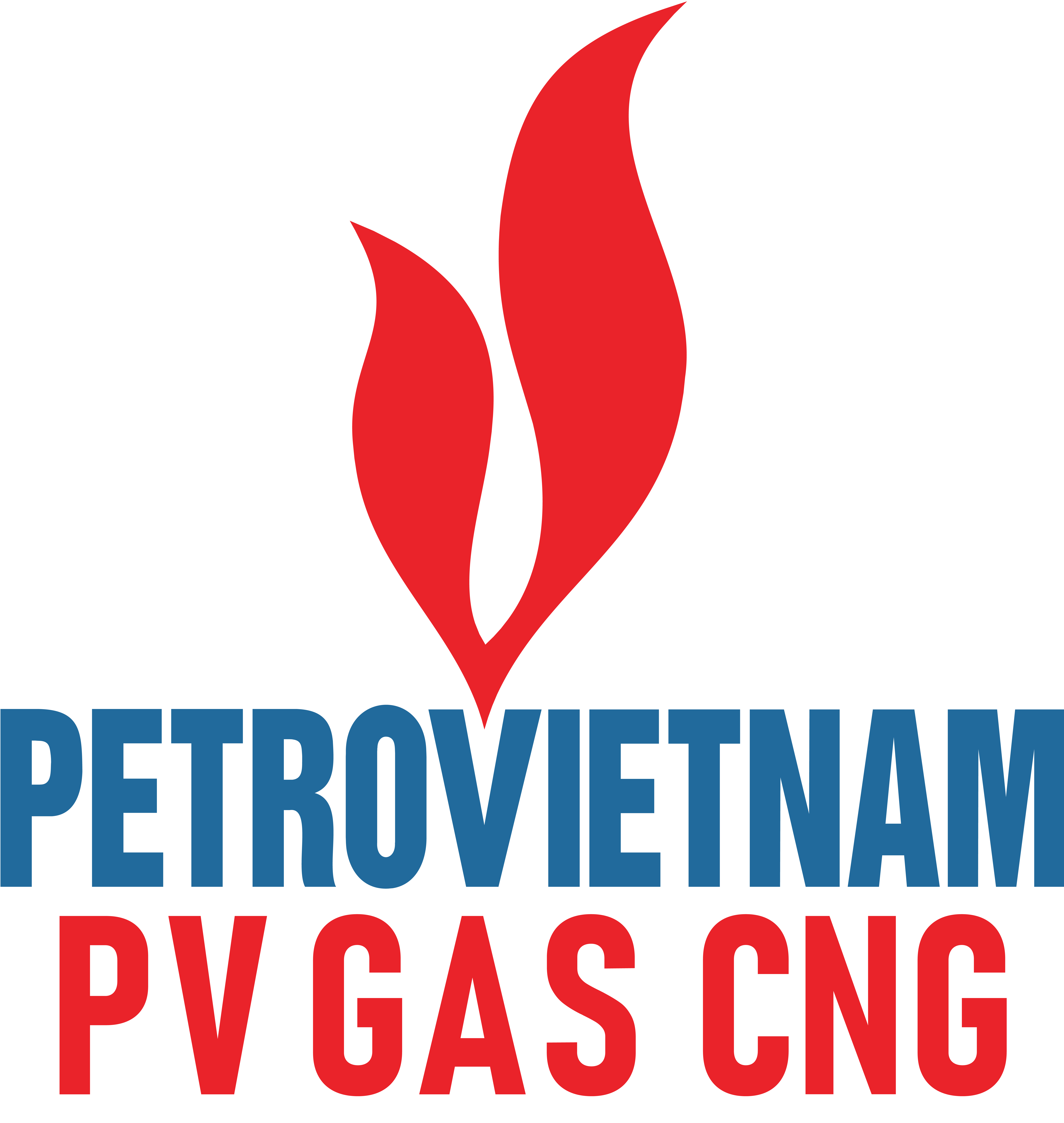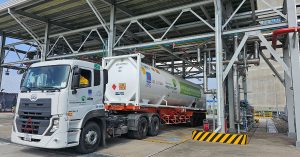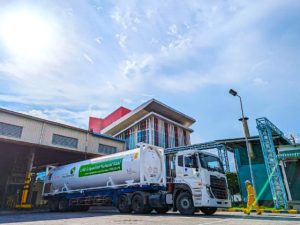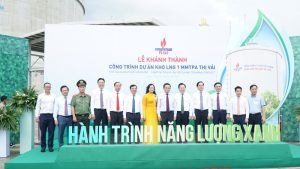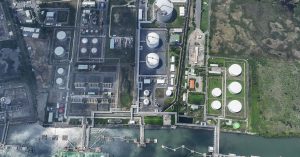Introduction of Liquefied Natural Gas (LNG):
LNG stands for Liquefied Natural Gas. This gas is mainly composed of Methane CH4 (94.3%), colorless, odorless, non-toxic and cooled at a very low temperature (about -120 to -170ºC to convert to liquid). The most suitable temperature for liquefaction and removal of impurities in LNG is -163ºC. Gases that are separated from raw natural gas before liquefaction include propane, butane (n-butane), and isobutane (i-butane). After being liquefied, the capacity of LNG is 2.4 times higher than that of CNG (Compressed Natural Gas).
Because it occupies only 1/600th of the volume compared to natural gas at standard conditions (15ºC, 1 atm), LNG is a convenient gas product for storage and transportation from production to markets in the world. Currently, the main means of transport are LNG carrier (tank ship) with a tonnage of 170,000 m3 to 260,000 m3, of which, the most common tonnage is from 155,000 m3 to 170,000 m3. After being transported to the point of consumption, LNG is converted back to the gaseous state when it passes through the re-gasifier and then pumped into the pipeline to be transported to industrial and civil consumers.
LNG is used similarly to dry gas to serve the gas needs of power plants, industrial consumers and urban areas. Currently, in many countries around the world, LNG is also used as a fuel for transportation vehicles such as ships, trains and heavy trucks to reduce environmental pollution.
LNG reserves of potential countries:
According to the US Energy Information Administration (EIA): Proven reserves of natural gas in the world for the period 1960 – 2012 are based on data from the CIA’s The World Factbook and EIA… However, this number is only relative, with 3 countries considered to be dominant, including: Iran, Russia and Qatar.
There is some disagreement about which country has the largest gas reserves. For example, according to the CIA, Russia has the largest proven reserves of 47,600 km³, according to the EIA the figure is 49,000 km³, and 48,810 km3 according to OPEC. However, according to BP, Russia has only 32,900 km³, only ranked second, slightly behind Iran, 33,100 to 33,800 km³.
Due to the constant announcements of recoverable reserves of shale gas, as well as exploratory drilling in Central Asia, South America and Africa, deep-water drilling, estimates are being updated regularly, most are increase. Since 2000, a number of countries, notably the US and Canada, have seen large increases in proven gas reserves due to shale gas developments, but shale gas deposits in most countries have not yet been added to the reserve calculation.
Proven gas reserves (km³) of the top 10 countries in the world:
| Country
| According to EIA (From 2021) | According to OPEC (From 2018) | According to BP (From 2018) | Production volume
km³/ (2020) | Number of years of reserve | Notes
|
|---|---|---|---|---|---|---|
| Russia
| 47.798
| 50.617
| 35.000
| 624
| 77
|
|
| Iran
| 33.980
| 33.810
| 33.200
| 238 (2019)
| 143
|
|
| Qatar
| 23.871
| 23.861
| 24.900
| 167 (2019)
| 143
|
|
| Saudi Arabia
| 15.910 (2022)
| 8.715
| 8.000
| 114
| 140
|
|
| US
| 13.167 (2020)
| 9.067
| 8.700
| 947
| 14
|
|
| Turkmenistan
| 11.326
| 9.838
| 19.500
| 84 (2019)
| 135
|
|
| China
| 6.654
| 2.934
| 5.500
| 179 (2019)
| 37
|
|
| UEA
| 6.088
| 6.091
| 5.900
| 63
| 97
|
|
| Nigeria
| 5.748
| 5.627
| 5.200
| 46 (2019)
| 125
|
|
| Venezuela
| 5.663
| 5.707
| 6.400
| 23 (2019)
| 246
|
|
| Algeria
| 4.502
| 4.504
| 4.300
| 88 (2019)
| 51
|
The world’s top 10 natural gas producers:
According to the Canadian online energy news site Visualcapitalist: These 10 top natural gas producing countries account for about 73% of the world’s total natural gas production today. Specifically:
| Country
| Production volume 2021 (billion m3) | Market Share (%)
|
|---|---|---|
| US
| 934,2
| 23,1
|
| Russia
| 701,7
| 17,4
|
| Iran
| 256,7
| 6,4
|
| China
| 209,2
| 5,2
|
| Qatar
| 4,4
| |
| Canada
| 172,3
| 4,3
|
| Australia
| 147,2
| 3,6
|
| Saudi Arabia
| 117,3
| 2,9
|
| Norway
| 114,3
| 2,8
|
| Algeria
| 100,8
| 2,5
|
|
| Total 4.036,9
| 100%
|
Natural gas accounts for 32% of primary energy consumption in the US, the world’s largest producer. Russia is the second largest producer and also has the largest reserves of natural gas in the world. China’s natural gas production has grown by 7.8% in 2021 and has nearly doubled since 2011. This sustained output growth is partly due to government policies encouraging the transition from coal to gas. Despite these efforts, Europe remains dependent on Russia for natural gas supplies, at least in the short and medium term.
World’s LNG trading partners that Vietnam can cooperate:
According to Japanese online news site Jiapex.co.jp (JCJ): The LNG market in Vietnam is attracting foreign investors. Vietnam’s LNG market is very active and growing, especially LNG gas power plant projects and LNG warehouses. In the context that the world is moving towards the goal of carbon neutrality, LNG is considered important in improving the security of energy supplies, reducing air pollution and supporting the energy transition for Vietnam in the future.
According to the British news agency Reuters at the end of July 2022: Vietnam and the US are looking for opportunities to cooperate in investment and development of clean energy. At the recently held Vietnam Energy Summit (VES), Vietnam emphasized its goal of reaching net zero emissions by 2050. Reuters quoted Mr. Ken Haig – Director of European Energy Policy Asia – Pacific and Japan of Amazon Web Service (AWS) – a company of Amazon.com: Vietnam and the US have many potential cooperation projects in the fields of electricity, clean energy, renewable energy, contributing to harmonious two-way trade development and achieving the goal of energy security. It must also be added that Vietnam’s primary energy supply is somewhat limited, Vietnam has had to import coal and shortly it has to import LNG to satisfy its energy needs.
According to Reuters: Chan May LNG – a US-Vietnam joint venture (US investors own 60% and the Vietnamese side 40%) plans to invest up to 6 billion USD for a power project in Vietnam, when they discovered that the demand for electricity and gas in Southeast Asia in general and Vietnam is very potential. The project locates in Thua Thien Hue province (including a 4 GW power plant, an LNG depot and storage facilities), John Rockhold, co-founder of the consortium told Reuters on the sidelines of Vietnam Energy Summit (VES). Construction of the power plant in Thua Thien Hue province is expected to begin next year. The first phase of 2.4 GW comes into operation from 2024 and the entire plant runs from 2027. “We received great support from the US Government for the project, as they have LNG for sale. We have a number of LNG suppliers in the United States, so it is very convenient to be able to shop at any time,” said Rockhold.
When fully operational, the project will import approximately USD1.2 billion worth of US LNG per year. This will help narrow the US trade deficit with Vietnam. Vietnam is looking to import more US goods, such as coal and LNG, to close the trade gap after President Donald Trump threatened tariffs on Vietnamese products amid the US – China trade war tension.
According to sputniknews – one of the largest gas producers in the world that Vietnam can cooperate with is Russia’s leading corporation: OJSC Gazprom (Gazprom). This group intends to invest nearly 300 million USD in a gas power project in Quang Tri. This is a key project to turn Quang Tri province into an energy center in the Central region by 2030, in which Gazprom International (GI) is the direct implementation company. The project, or plant with a capacity of 340 MW, uses combined cycle gas turbine technology. This is an investment project in the form of a build-operate-transfer (BOT) contract, built in Southeast Quang Tri Economic Zone on a land use area of about 42.23 ha. Gazprom International said that the investor focused on researching the consumption market; cooperate with operators in the region to connect existing gas fields, which, when operational, will add more electricity to load demand in the central region.
Up to now, the LNG project that is being completed and will be the first project to come into operation is PV GAS’ LNG Thi Vai terminal. The first phase of the project is a port, gasification workshop and warehouse with a capacity of 1 million tons of LNG/year, supplying Nhon Trach 3, 4 gas power plants and industrial customers./.
